Abstract
The coastline is a constantly evolving boundary between land and sea, shaped by natural forces and human activities. Given its significant ecological and economic value, this zone faces increasing pressures, highlighting the need for continuous monitoring and improved understanding to support sustainable management. This study analyses the spatial and temporal changes along the Al Qunfudhah coastline from 1984 to 2020. Using a combination of multi-temporal Landsat satellite images and geographic information system tools—specifically the digital shoreline analysis system—the research tracks changes over time. Shoreline positions were accurately extracted using automated methods, particularly the Canny edge detection algorithm. Over the 36-year period, analysis using the linear regression rate (LRR) and end point rate (EPR) methods revealed a general pattern of slight shoreline advancement. The highest rates of accretion were recorded at 12.43 m/year (LRR) and 13.36 m/year (EPR), with average rates of 3.63 m/year and 4.17 m/year, especially in the northern region where a corniche road was developed along the coast. Conversely, the most significant erosion occurred near the boat port, with maximum rates reaching −24.4 m/year (LRR) and −20.9 m/year (EPR) and average rates of −1.23 m/year and −1.08 m/year. These results offer valuable insights into the factors driving coastal changes and provide a scientific foundation for making informed, sustainable decisions about the future of the Al Qunfudhah coastline.
1. Introduction
Coastal zones are widely recognised by scientists as some of the most physically dynamic environments on the planet [,,]. These areas are continuously reshaped by various natural forces, including wave activity, wind patterns, and directional changes, which can both erode and rebuild shorelines [,,,]. According to a 2016 study by [], approximately 80% of the world’s coastlines are currently undergoing some form of change, with transformation rates ranging from 1 centimetre to as much as 10 m per year. This wide variability underscores the importance of understanding the complex drivers of coastal change. While natural forces remain central to this process, increasing attention is being directed toward the growing influence of human activities on these fragile landscapes. A critical question researchers continue to explore is whether such coastal changes are reversible under stable environmental conditions or represent permanent shifts driven by contemporary climate and development pressures [,,].
Human activities—particularly coastal development and resource exploitation—now play a major role in reshaping shoreline morphology. The rapid expansion of populations in coastal areas has intensified pressure on these already sensitive ecosystems, increasing their vulnerability and accelerating environmental degradation [,]. Ref. [] found that unsustainable resource use and the removal of native coastal vegetation are among the most damaging human-induced factors contributing to shoreline instability. These findings emphasise the urgent need for precise shoreline mapping and regular monitoring to identify potential hazards early—an essential step not only for research but also for sustainable urban planning.
To study shoreline change over time, researchers have traditionally relied on historical sources such as aerial photographs, maps, and topographic surveys to track long-term trends [,,,,]. However, recent advances in satellite remote sensing and geographic information systems (GISs) have significantly improved our ability to analyse coastal dynamics. These tools now offer high-resolution, up-to-date datasets that are increasingly accessible to the scientific community [,,,]. By combining satellite imagery with geomorphological and sedimentary data, researchers can generate detailed maps that capture shoreline changes over extended periods with greater accuracy.
Still, challenges persist in accurately identifying and measuring shoreline change. A key difficulty lies in consistently defining the shoreline itself. Many studies adopt the mean high-water line as a standard reference point for shoreline position [,,].
Globally, efforts continue to refine remote sensing techniques for shoreline monitoring. For example, ref. [] evaluated the effectiveness of Landsat 8 and Sentinel-2A imagery in detecting shoreline erosion, accretion, and land reclamation. Their study produced high-resolution spatial data, compared results across satellite platforms, and updated shoreline records spanning from 1962 to 2016. Similarly, ref. [] assessed coastal changes along Egypt’s El-Alamein shoreline using multiple satellite systems—Landsat 8 OLI (30 m), Sentinel-2A MSI (10 m), and PlanetScope 3B (3 m)—over a five-year period from 2016 to 2021.
Other studies have employed geoinformatics to examine broader patterns of shoreline change and their environmental implications. For instance, ref. [] emphasised the importance of continuous monitoring in Europe’s coastal lagoons and fjords—particularly in regions of restricted exchange—to help prevent further ecological degradation.
In the Red Sea region, unique coastal features such as wadis, spits, tidal flats, and sabkhas contribute to highly complex morphological dynamics. Fed by the Indian Ocean through the Bab el-Mandeb Strait, the Red Sea is subject to high evaporation rates caused by extreme temperatures—conditions that make it an ideal natural laboratory for coastal research (as depicted in Figure 1). Given these environmental sensitivities, monitoring and managing the region’s shorelines is of strategic importance, both scientifically and legislatively.
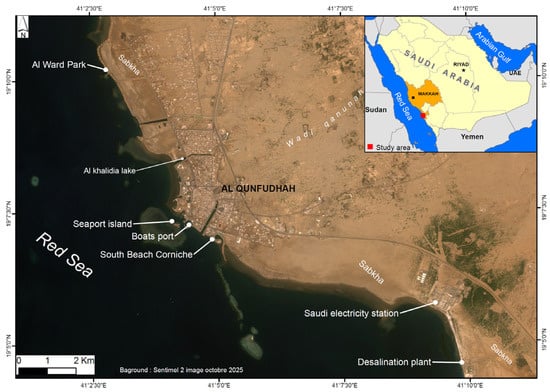
Figure 1.
Study area.
Although the Red Sea holds significant potential for coastal studies, relatively few researchers have utilised remote sensing techniques to examine this region. At the regional level, only a few studies have been interested in the dynamics of the coastline in Saudi Arabia [,,,]. One of the earlier efforts was by [], who used satellite imagery from 1972 to 2007 to study shoreline erosion along the Marsa Alam–Hamat stretch. Around the same time, ref. [] analysed patterns of erosion and accretion along Yemen’s Red Sea coastline. In another study, ref. [] focused on shoreline changes near Hurghada, Egypt.
In 2016, ref. [] applied remote sensing software to examine geological and geomorphological shifts along the Ras Al-Shabaan coastline in Saudi Arabia, using enhanced thematic mapper plus (ETM+) imagery from 1990 and 2010. Likewise, ref. [] investigated coastal changes along the southeastern part of Saudi Arabia’s Red Sea coast, using a series of satellite datasets—multispectral scanner, thematic mapper (TM), and ETM+—spanning the years from 1973 to 2011.
More recently, ref. [] explored shoreline variations in Yanbu using multi-temporal satellite imagery collected between 1965 and 2019. Ref. [] also studied changes in the Rabigh coastal area using a combination of SPOT-CIB, Landsat TM/ETM+, and Sentinel-2 imagery. His analysis was divided into three time periods—1986–1998, 1998–2005, and 2005–2019—and applied both the end point rate (EPR) and linear regression rate (LRR) methods to improve result accuracy.
These studies have played an important role in detecting and quantifying patterns of coastal erosion and land build-up. Their findings offer valuable insights for environmental managers and urban planners developing targeted strategies to protect at-risk shorelines in the Red Sea region.
2. Physical Setting of the Study Area
The Red Sea is a long, narrow extension of the Indian Ocean situated between the northeastern coast of Africa and the Arabian Peninsula. It extends approximately 2300 km in length and has an average width of 355 km. Known for its high temperatures and salinity, it ranks among the warmest and saltiest seas in the world [].
The Red Sea coastal zone is characterised by a variety of distinct geomorphological and ecological features shaped by regional tectonics, climate, and marine dynamics. It includes extensive coral reefs, mangrove stands, sabkhas (salt flats), and sandy and rocky shorelines, with varying distributions along the African and Arabian coasts [].
The region experiences a tropical climate marked by high temperatures and low rainfall, averaging around 63 mm annually. There are no significant riverine inputs to the Red Sea in this area. Annual evaporation rates average approximately 2.06 ± 0.22 m [], and surface water temperatures show seasonal variations of up to 10 °C, ranging from 22 °C to 32 °C. Relative humidity also varies seasonally, from about 50% in winter to as high as 68% in summer, often peaking higher under the midday sun. Wind patterns strongly influence the regional climate. As noted by [,], wind speeds generally increase toward the north along the coast. The dominant wind direction is north–north-westerly for most of the year, with average speeds of 7–12 km/h. However, during the cooler winter months, winds may occasionally shift to originate from the south [].
Al Qunfudah, a governorate in the Makkah Province of Saudi Arabia, is located on the Kingdom’s western coast at 19°07′34″ N, 41°04′43″ E, approximately 340 km south of Jeddah (see Figure 1). The study area spans 22 km along the coastline and features a diverse range of landforms, including wadis, sabkhas, tidal flats, coral reefs, and sand dunes.
Several islands lie off the coast of Al Qunfudah, listed from north to south: Safiq Island, Umm ar Rak Island, Al Qurunatayn Island, Al Aghtham Island, Umm al Qamari Island, Umm al Ashim, and as Siyyal. The coastal area is underlain by Quaternary coastal deposits and wadi sediments—particularly from Wadi Yabah, Qanunah, Lumah, and al Ahsabah—as well as eolian deposits composed of sand, gravel, and silt [].
Topographically, the eastern part of the region is defined by the Red Sea Escarpment, a landform that runs northwest and rises to about 1000 m in elevation, with a steep descent to the west. South of the escarpment, the landscape transitions into modest mountains and ridges, ranging in height from 100 to 300 m. From this elevated zone, a broad and mostly level coastal plain—measuring 25 to 40 km wide—extends southwest toward the Red Sea [].
3. Materials and Methods
3.1. Data Sources
A series of Landsat satellite images—captured by the TM, ETM+, and Operational Land Imager (OLI) sensors—were utilised to analyse the Al Qunfudhah coastal region across five time points: 1984, 1990, 2000, 2010, and 2020. These datasets, each offering a spatial resolution of 30 m, were obtained from the United States Geological Survey and are publicly accessible via the Earth Explorer platform (https://earthexplorer.usgs.gov; accessed on 31 October 2025). Comprehensive details of the imagery used are presented in Table 1.

Table 1.
Overview of Satellite Imagery Utilized in the Study.
3.2. Data Processing
The data used in this study had already undergone geometric and radiometric correction, but further standardisation was necessary to ensure consistency across all Landsat imagery types (TM, ETM+, and OLI). To ensure consistency across all datasets, the vector layers were reprojected into the Universal Transverse Mercator (UTM) coordinate system, referenced to the WGS-84 datum.
The primary aim of the pre-processing phase was to improve the quality of the imagery, making it more suitable for accurate analysis. This process included radiometric adjustments and the application of the fast line-of-sight atmospheric analysis of hypercubes (FLAASH) algorithm to correct atmospheric effects. To enhance the distinction between land and water features, the normalised difference water index was also applied, allowing for more precise identification of water bodies.
3.3. Automatic Coastline Extraction
Threshold Extraction Methodology (Threshold-Based Edge Detection Mechanism)
Thresholding is a widely used method in image processing that filters or isolates specific data based on a set threshold value. This technique is mathematically described in Equation (1). In the equation, the pixel value in the image is denoted by ‘x’, while ‘λ’ represents the threshold value that determines whether a pixel should be retained or removed. When the pixel value ‘x’ is less than or equal to the threshold ‘λ’, that pixel is removed. The threshold value retained in this study is 0.5 but it can change sometime in complex shoreline configuration. This step improves the precision of coastline extraction from the image.
To prepare images for processing, RGB images are first converted to grayscale, which may lead to a reduction in image resolution. After pre-processing, coastlines are automatically extracted as vector data for each year under study (by converting the raster to vector). An example of the extracted coastline for the year 2020 is shown in Figure 2.
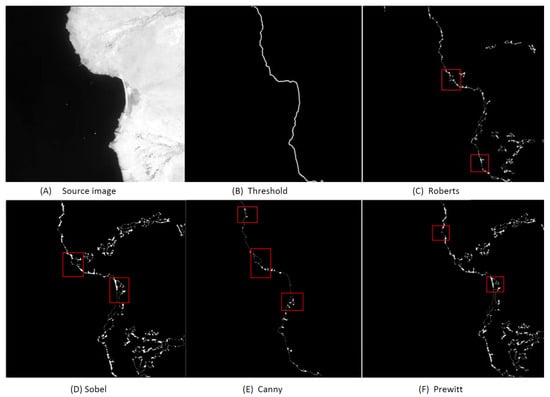
Figure 2.
Shoreline extraction using different methods for the 2020 image. The red box shows the limitations of basic thresholding.
To address the limitations of basic thresholding, this study employs a Canny-based edge detection method, which is recognised for its accuracy in generating fine, well-defined coastline edges [].
3.4. Estimation of Shoreline Position Uncertainty
Several sources of uncertainty in shoreline research have been identified in previous studies []. In this study, three primary types of uncertainty are considered: georeferencing error (Eg), error associated with the shoreline extraction method (Ec), and pixel-based error (Ep). As the tidal range in the study area is minimal (about 50 cm), it was not regarded as a significant source of uncertainty and was therefore excluded []. The total uncertainty (U) in shoreline positioning across different time periods was estimated using Equation (2):
The average positional uncertainty for the shorelines obtained from various data sources was approximately 25.9 m. In addition, the uncertainty related to the rate of shoreline change was also assessed. This was calculated by first taking the square root of the sum of the positional uncertainties for each shoreline year and then dividing that value by the number of years between the two shoreline measurements. The estimated error in shoreline-change rates reflects the annualised uncertainty, which is approximately ±3.6 m per year for the initial six-year period (1986–1990) and about ±2.2 m per year for the subsequent periods.
3.5. Calculation and Interpretation of Shoreline-Change Rates
To assess shoreline-change rates, the Digital Shoreline Analysis System (DSAS), was employed. DSAS is a free extension that operates within the ESRI ArcGIS 10.8 platform, and this study used version 5.0, developed by the U.S. Geological Survey []. The software calculates shifts in shoreline positions across different periods by generating transects that are cast perpendicularly from a user-defined baseline at specified intervals. In this study, transects were placed at 100 m intervals along the Al-Qunfudhah coast. The intersections of the various shoreline positions with these transects were then used to calculate shoreline-change rates through six different statistical methods. For a more detailed examination of coastal dynamics, this study focused on two of these methods: the End Point Rate (EPR) and the Linear Regression Rate (LRR).
The EPR method was applied to measure changes between pairs of shoreline positions over four distinct periods: 1984–1990, 1990–2000, 2000–2010, and 2010–2020. It calculates change by dividing the distance between two shoreline positions by the number of years separating them. In contrast, the LRR method considers all shoreline data points over time to estimate a long-term rate of change across the entire 36-year study period (1984–2020). As noted by [], LRR tends to yield more reliable results when evaluating shoreline changes along different sections of the coast and often outperforms both EPR and the weighted linear regression method.
Although LRR is effective for identifying long-term shoreline trends, it does not capture short-term variations or fluctuations that may indicate acceleration or deceleration of erosion or accretion due to natural or anthropogenic factors []. To address this, average EPR values were calculated for each time segment, providing a clearer picture of how shoreline dynamics shifted throughout the study period. All periods, except the first (1984–1990), covered ten years, enabling more consistent temporal comparisons of changes along the Al Qunfudhah shoreline. A summary of the study workflow is presented in Figure 3.
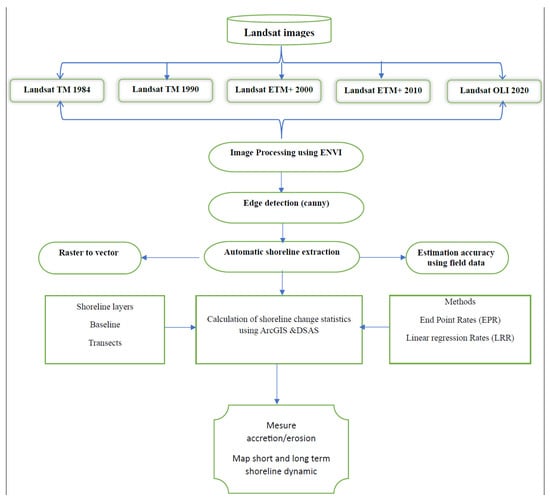
Figure 3.
Flowchart of the approach used in this research.
3.6. Validation Procedures and Potential Limitations of the Automatic Shoreline Extraction Methods
To validate the shoreline extraction methodology, we compared several algorithms and found that the Canny edge detector produced the most reliable results []. The accuracy of the extracted coastlines was assessed against NDWI outputs, ground control points collected in the field, and high-resolution imagery from Google Earth. The findings indicate a high level of accuracy, with coastline delineation exceeding 95%. The main limitations in accuracy stem from the spatial resolution of the imagery used (30 m). Employing higher-resolution datasets, such as Sentinel-2 imagery, would likely yield more precise results; however, these datasets are only available from 2015 onwards.
The application of this method to the Red Sea coast, which is subject to significant erosion due to several geological and environmental factors, including its nature as a deep continental trench, the absence of reefs to cushion waves, and the low level of beach nourishment from rivers, allows us to test its effectiveness.
4. Results and Discussion
4.1. Long-Term Period Analysis
To examine long-term shoreline movement between 1984 and 2020, the LRR method was used. This approach calculates the rate of change by fitting a least-squares regression line through all recorded shoreline positions along each transect, from the earliest to the most recent. The results of this analysis are presented in Figure 4. In this context, positive LRR values indicate areas where the shoreline has advanced (accretion), while negative values denote zones of retreat or erosion.
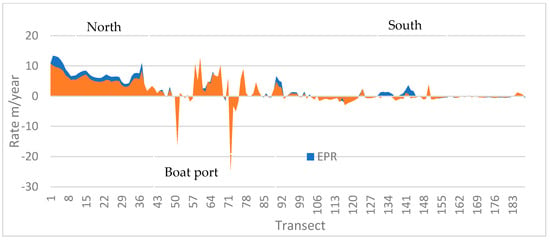
Figure 4.
Long-term shoreline-change rate using LRR and EPR, 1984–2020. Transects with orange colour indicate erosion and the blue colour show accretion rates.
Over the 36-year study period, both the LRR and EPR analyses indicate a modest overall trend of shoreline accretion, with average rates of 1.43 m/year and 1.91 m/year (±1.18), respectively. According to the LRR findings, approximately 54.79% of the transects showed shoreline advancement, while 45.21% reflected retreat, suggesting a general tendency toward coastal progradation.
The highest accretion rates were recorded in the northern part of the study area, reaching up to 12.43 m/year (LRR) and 13.36 m/year (EPR), with average accretion in this zone estimated at 3.63 m/year (LRR) and 4.17 m/year (EPR). This area aligns with the construction of a coastal corniche road, highlighting the role of human intervention. In contrast, the most significant erosion occurred near the boat port, with rates of −24.4 m/year (LRR) and −20.9 m/year (EPR) and average erosion values of −1.23 m/year and −1.08 m/year, respectively.
Throughout the study period, some shoreline sections exhibited pronounced localised erosion or accretion, particularly in areas with high levels of human activity. Much of the coastal landscape has been altered by ongoing infrastructure development. The results clearly demonstrate that human intervention is the primary driver of the most substantial shoreline changes, as illustrated in Figure 5.
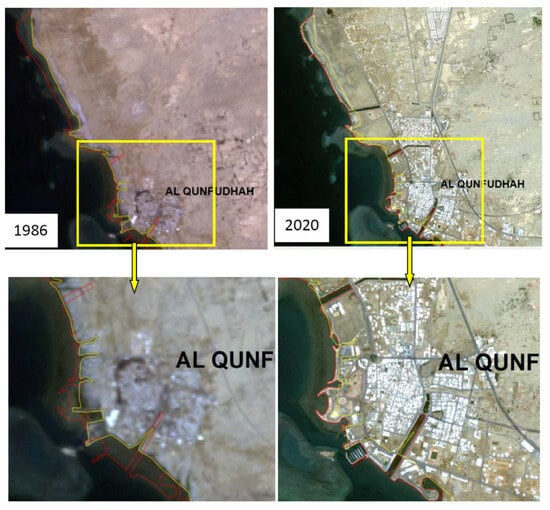
Figure 5.
Coastal changes and locations of notable accretional and erosional areas along the Al Qunfudhah coast between 1984 and 2020. From True color composite Landsat images.
4.2. Short-Term Period EPR Analysis
The EPR method was used to assess shoreline changes across four specific time periods: 1984–1990, 1990–2000, 2000–2010, and 2010–2020. Each of these intervals represents a distinct stage in the coastal development process, shaped by both natural forces and human impact. By examining how these changes are distributed spatially and analysing their statistical relevance along the transects, the study sheds light on the evolving patterns and key factors driving shoreline shifts in the Al Qunfudhah area.
The short-term analysis reveals both spatial and temporal variability in coastal dynamics across the selected intervals. This approach is especially effective in regions undergoing significant human activity, as it allows for the monitoring of different phases of coastal infrastructure development over time. Consequently, evaluating the pace and direction of shoreline evolution relies heavily on interpreting data stored within the attribute tables generated by the DSAS tool. Figure 6a,b present the EPR results for the four selected time intervals. The variation rates shown—particularly in Figure 6b—highlight zones of notable shoreline advancement and retreat, illustrating that the patterns and intensity of change differ noticeably across the analysed periods. These variations underscore the dynamic and non-uniform nature of coastal transformation over time.
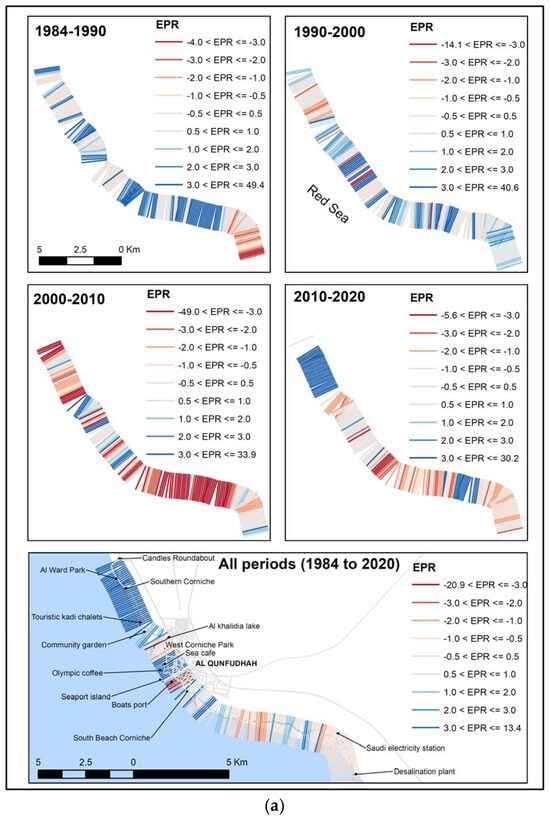
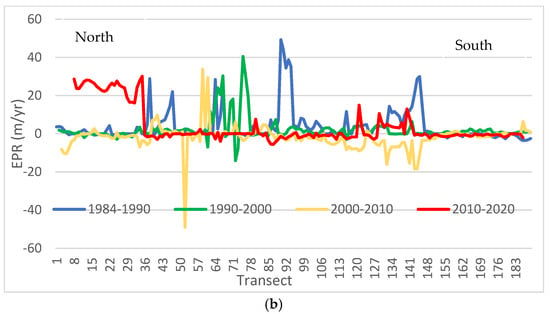
Figure 6.
(a) Shoreline-change rates (EPRs) in m/year for all transects during 1984–1990, 1990–2000, 2000–2010, 2010–2020, and 1984–2020. Red indicates erosion (negative values), blue indicates accretion (positive values); (b) Average change rates across all periods for comparison.
4.2.1. Shoreline Changes Between 1984 and 1990
This initial period, the shortest in the study, presents a predominantly accretional phase. Approximately 60.45% of transects showed shoreline advance, while 39.55% experienced erosion. The most pronounced accretion (up to 49.3 m/year ± 3.6 m/year) occurred near the Al Shalal garden, an area characterised by minimal construction. This suggests that, in the absence of intense development, natural sediment deposition processes dominated.
In contrast, the maximum erosion rate of −3.45 m/year was identified in the southern part of the study area, adjacent to the desalination plant. This indicates that even early in the study period, localised infrastructure had begun to disrupt natural sediment transport, likely by interrupting littoral drift or accelerating wave energy through shoreline hardening.
The average erosion rate (−0.65 m/year), although not severe, suggests initial signs of coastal stress linked to early-stage urban expansion. Overall, the results indicate a coastline still largely under the influence of natural dynamics, with only limited anthropogenic disturbance.
4.2.2. Shoreline Changes Between 1990 and 2000
This second period marks a clear shift towards accelerated progradation. The EPR results show that 74.05% of transects were accretional, and notably, 8.65% exhibited statistically significant shoreline advancement. Only 25.95% of transects were erosional, with just 2.16% showing statistically significant rates.
This decade coincides with a phase of rapid coastal development and infrastructure investment, particularly in the northern and central zones of Al Qunfudhah. The enhanced progradation may be linked to coastal stabilisation projects, such as groynes or revetments, which trap sediment and prevent erosion in targeted areas. Additionally, sediment accumulation from inland construction runoff may have contributed to the observed shoreline growth.
Despite the high percentage of accretional transects, the uneven distribution of significant trends suggests that human activity was influencing certain hotspots more than others, creating a fragmented pattern of change. This period appears to mark a turning point, where anthropogenic forces began to surpass natural coastal processes in shaping the shoreline.
4.2.3. Shoreline Changes Between 2000 and 2010
A dramatic reversal is observed in this interval, with 68.28% of transects classified as erosional and 18.82% of them showing statistically significant retreat. Accretion was limited to 31.72% of transects, of which only 4.84% were statistically significant. This shift signals a critical degradation phase in the coastal system.
The maximum erosion rate of −49.0 m/year was recorded near Al Khalidia Lake, an area heavily affected by land reclamation and drainage activities. Such interventions can destabilise sediment balance and amplify erosion through reduced water buffering and altered tidal flows.
In contrast, the highest accretion rate (33.81 ± 4.32 m/year) was observed in zones associated with recreational developments, likely tied to beach nourishment or artificial filling projects. These interventions are typically short-term solutions that displace erosion pressures rather than resolve them. The sharp contrast between localised accretion and widespread erosion during this decade reflects a coastline under stress, struggling to adapt to uncoordinated human interventions and possibly intensified climatic factors such as rising sea levels or storm surges.
4.2.4. Shoreline Changes Between 2010 and 2020
The final decade of the analysis continues to show an erosional trend, though it is slightly less severe than in the previous period. A total of 56.91% of transects were erosional, with only 1.1% showing statistically significant retreat. Conversely, 43.09% of transects exhibited shoreline advance, and 24.86% of those showed statistically significant accretion.
The maximum erosion rate (−5.54 m/year) and an average rate of −1.23 m/year suggest that, while erosion persists, it has stabilised to some extent compared to the 2000–2010 period. This improvement may be attributed to coastal management strategies implemented in response to the sharp degradation observed earlier.
The highest accretion rate (30.2 m/year) was recorded in the northern coastal zone, an area of ongoing human development, particularly recreational infrastructure. These results highlight the growing influence of urban planning and shoreline engineering in shaping modern coastal dynamics.
Note that estimating rates of change from instantaneous coastlines is tricky because they are strongly influenced by tidal and wave fluctuations. Different resolutions can reveal varying variability and trends in the position of the coastlines, which is why we decided to maintain the same resolution. However, the accuracy of the automatically extracted shorelines is also limited by errors related to the low resolution of the images used.
The results obtained for Al-Qunfudhah are consistent with those reported from other parts of the Red Sea, such as Yanbu and Jeddah [,,,]. In many cases, observed changes in coastline dynamics can be attributed to human activities.
5. Conclusions
Shoreline changes along the Al Qunfudhah coast between 1984 and 2020 were analysed using a combination of modern techniques. These included automatic shoreline detection via the Canny edge detection algorithm, multi-temporal Landsat satellite imagery, and spatial analysis using GIS tools. The Canny algorithm proved especially effective in clearly and accurately delineating the coastline, producing sharp and reliable shoreline maps. To calculate shoreline-change rates, the study employed DSAS, applying two main statistical methods: the EPR for identifying short-term changes between successive periods and the LRR for examining long-term trends across the full 36-year period.
The results indicate that, over the past four decades, Al Qunfudhah has experienced steady urban expansion, placing increasing pressure on its coastal zones. The long-term analysis revealed a moderate trend of shoreline advance, with average rates of 1.43 m per year (LRR) and 1.91 m per year (±1.18, EPR). According to LRR findings, 54.79% of the measured transects showed shoreline advancement, while 45.21% exhibited erosion. The most notable accretion occurred in the northern part of the study area, particularly near the newly constructed corniche road, where shoreline advance reached up to 12.43 m per year (LRR) and 13.36 m per year (EPR), with average gains of 3.63 and 4.17 m per year, respectively.
However, in the more recent decades—specifically from 2000 to 2010 and 2010 to 2020—a noticeable shift toward erosion was observed, signalling changes in coastal dynamics. The findings suggest that human activities such as coastal construction, land reclamation, and modifications to natural drainage systems are the main drivers of shoreline retreat. The study concludes that anthropogenic pressures are the primary cause of the significant coastal transformations observed in Al Qunfudhah. If these trends persist without effective intervention, the region faces continued environmental degradation and increased vulnerability to natural hazards. Accordingly, the study underscores the urgent need for coordinated and robust coastal management strategies to safeguard this vital and environmentally sensitive shoreline.
Author Contributions
Conceptualization, O.A.A.; methodology, A.J.N.; software, A.J.N.; validation, O.A.A. and A.J.N.; formal analysis, O.A.A. and A.J.N.; investigation, O.A.A.; resources, A.J.N.; data curation, O.A.A. and A.J.N.; writing—original draft preparation, O.A.A. and A.J.N.; writing—review and editing, O.A.A. and A.J.N.; visualization, O.A.A. and A.J.N.; supervision, O.A.A.; project administration, O.A.A.; funding acquisition, O.A.A. All authors have read and agreed to the published version of the manuscript.
Funding
This research received no external funding.
Institutional Review Board Statement
Not applicable.
Informed Consent Statement
Not applicable.
Data Availability Statement
The data presented in this study are available on request from the corresponding author.
Conflicts of Interest
The authors declare no conflicts of interest.
References
- Abd-Elhamid, H.F.; Zeleňáková, M.; Barańczuk, J.; Gergelova, M.B.; Mahdy, M. Historical trend analysis and forecasting of shoreline change at the Nile Delta using RS data and GIS with the DSAS tool. Remote Sens. 2023, 15, 1737. [Google Scholar] [CrossRef]
- Constance, A.; Bunbury, N.; Lack, N.; Nebiker, S.; Obura, D.; Fleischer-Dogley, F.; Schaepman-Strub, G. Low average shoreline change rate in 51 years on the raised Aldabra Atoll. Sci. Rep. 2024, 14, 28970. [Google Scholar] [CrossRef]
- Chawalit, C.; Boonpook, W.; Sitthi, A.; Torsri, K.; Kamthonkiat, D.; Tan, Y.; Nardkulpat, A. Geoinformatics and machine learning for shoreline change monitoring: A 35-year analysis of coastal erosion in the upper Gulf of Thailand. ISPRS Int. J. Geo-Inf. 2025, 14, 94. [Google Scholar] [CrossRef]
- Thomas, T.; Phillips, M.R.; Williams, A.T.; Jenkins, R.E. A multicentury record of linked nearshore and coastal change. Earth Surf. Process. 2011, 36, 995–1006. [Google Scholar] [CrossRef]
- Thomas, T.; Phillips, M.R.; Williams, A.T.; Jenkins, R.E. Short-term beach rotation, wave climate and the NAO. Prog. Phys. Geogr. 2011, 35, 333–352. [Google Scholar] [CrossRef]
- Alharbi, O.A.; Phillips, M.R.; Williams, A.T.; Thomas, T.; Hakami, M.; Kerbe, J.; Niang, A.J.; Hermas, E.; Al-Ghamdi, K. Temporal shoreline change and infrastructure influences along the southern Red Sea coast of Saudi Arabia. Arab. J. Geosci. 2017, 10, 360. [Google Scholar] [CrossRef]
- Kermani, S.; Boutiba, M.; Guendouz, M.; Guettouche, M.S.; Khelfani, D. Detection and analysis of shoreline changes using geospatial tools: Case of Jijelian sandy coast (East Algeria). Ocean Coast. Manag. 2016, 132, 46–58. [Google Scholar] [CrossRef]
- Pethick, J. The sustainable use of coasts: Monitoring, modelling and management. Stud. Eur. Coast. Manag. 1996, 1, 83–92. [Google Scholar]
- Esteves, L.S.; Toldo, E.E., Jr.; Dillenburg, S.R. Long and short-term coastal erosion in southern Brazil. J. Coast. Res. 2002, SI35, 273–282. [Google Scholar] [CrossRef]
- Warrick, J.A.; Buscombe, D.; Vos, K.; Bryan, K.R.; Castelle, B.; Cooper, J.A.G.; Harley, M.D.; Jackson, D.W.T.; Ludka, B.C.; Masselink, G.; et al. Coastal shoreline change assessments at global scales. Nat. Commun. 2024, 15, 2316. [Google Scholar] [CrossRef]
- Deb, D.; Uddin, M.M.; Mahbub-E-Kibria, A.S.M.; Das, M.K.; Hasan, M. Coastal vulnerability assessment to multi hazards in the exposed coast of Southeastern Coastal Region of Bangladesh. Reg. Stud. Mar. Sci. 2024, 73, 103484. [Google Scholar] [CrossRef]
- Tchindjang, M.; Mbevo Fendoung, P.; Kamgho, C. Coastal hazard and vulnerability assessment in Cameroon. J. Mar. Sci. Eng. 2025, 13, 65. [Google Scholar] [CrossRef]
- Balica, S.F.; Wright, N.G.; Van der Meulen, F. A flood vulnerability index for coastal cities and its use in assessing climate change impacts. Nat. Hazards 2012, 64, 73–105. [Google Scholar] [CrossRef]
- Crowell, M.; Leatherman, S.P.; Buckley, M.K. Historical shoreline change: Error analysis and mapping accuracy. J. Coast. Res. 1991, 7, 839–852. [Google Scholar]
- Thieler, E.R.; Danforth, W.W. Historical shoreline mapping (II): Application of DSAS to shoreline change mapping in Puerto Rico. J. Coast. Res. 1994, 10, 600–620. [Google Scholar]
- Fletcher, C.; Rooney, J.; Barbee, M.; Lim, S.C.; Richmond, B. Mapping shoreline change using digital orthophotogrammetry on Maui, Hawaii. J. Coast. Res. 2003, 38, 106–124. [Google Scholar]
- Fabris, M. Monitoring the coastal changes of the Po River delta (Northern Italy) since 1911 using archival cartography, multi-temporal aerial photogrammetry and LiDAR data. Remote Sens. 2021, 13, 529. [Google Scholar] [CrossRef]
- Valverde, F.; Taborda, R.; East, A.E.; Ponte Lira, C. Historical coast snaps: Using centennial imagery to track shoreline change. Remote Sens. 2025, 17, 1326. [Google Scholar] [CrossRef]
- Ahn, Y.; Shin, B.; Kim, K.H. Shoreline change monitoring using high resolution digital photogrammetric technique. J. Coast. Res. 2017, 79, 204–208. [Google Scholar] [CrossRef]
- Smith, K.E.; Terrano, J.F.; Pitchford, J.L.; Archer, M.J. Coastal wetland shoreline change monitoring. Remote Sens. 2021, 13, 3030. [Google Scholar] [CrossRef]
- Murray, J.; Adam, E.; Woodborne, S.; Miller, D.; Xulu, S.; Evans, M. Monitoring shoreline changes along the southwestern coast of South Africa from 1937 to 2020. Remote Sens. 2023, 15, 317. [Google Scholar] [CrossRef]
- Morgan, G.R.; Ellis, J.T.; Smith, E. Comparison of shoreline change from high resolution aerial and satellite imagery: A South Carolina case study. Pap. Appl. Geogr. 2024, 10, 229–246. [Google Scholar] [CrossRef]
- Zhang, K.; Huang, W.; Douglas, B.C.; Leatherman, S. Shoreline position variability and long-term trend analysis. Shore Beach 2002, 70, 31–35. [Google Scholar]
- Ervita, K.; Marfai, M.A. Shoreline change analysis in Demak, Indonesia. J. Environ. Prot. 2017, 8, 940–949. [Google Scholar] [CrossRef]
- Mitri, G.; Nader, M.; Abou Dagher, M.; Gebrael, K. Investigating the performance of Sentinel-2A and Landsat 8 imagery in mapping shoreline changes. J. Coast. Conserv. 2020, 24, 40. [Google Scholar] [CrossRef]
- Darwish, K.; Smith, S. A comparison of Landsat-8 OLI, Sentinel-2 MSI and PlanetScope satellite imagery for assessing coastline change in El-Alamein, Egypt. Eng. Proc. 2021, 10, 23. [Google Scholar]
- Tett, P.; Gilpin, L.; Svendsen, H.; Erlandsson, C.P.; Larsson, U.; Kratzer, S.; Fouilland, E.; Janzen, C.; Lee, J.; Grenz, C.; et al. Eutrophication and some European waters of restricted exchange. Cont. Shelf Res. 2003, 23, 1635–1671. [Google Scholar] [CrossRef]
- Nofal, R.; Abboud, I.A. Geomorphological evolution of marine heads on the eastern coast of Red Sea. Arab. J. Geosci. 2016, 9, 163. [Google Scholar] [CrossRef]
- Niang, A. Monitoring long-term shoreline changes along Yanbu, Kingdom of Saudi Arabia. J. Taibah Univ. Sci. 2020, 14, 762–776. [Google Scholar] [CrossRef]
- Alharbi, O. Geomorphologic Features Characteristic of the Rabigh Coastal Area of the Eastern Red Sea, Saudi Arabia, Using Field Studies and Sentinel 2 Imagery. J. King Abdulaziz Univ. Mar. Sci. 2020, 30, 37–55. [Google Scholar]
- Dewidar, K. Changes in the shoreline position caused by natural processes for coastline of Marsa Alam–Hamata, Red Sea, Egypt. Int. J. Geosci. 2011, 2, 523–529. [Google Scholar] [CrossRef]
- Sagheer, A.A.; Humade, A.; Al-Jabali, A.M. Monitoring of coastline changes along the Red Sea, Yemen. Glob. Geol. 2011, 14, 241–248. [Google Scholar]
- El-Asmar, H.M.; Ahmed, M.H.; El-Kafrawy, S.B.; Oubid-Allah, A.H.; Mohamed, T.A.; Khaled, M.A. Monitoring and assessing the coastal ecosystem at Hurghada, Red Sea coast, Egypt. J. Environ. Earth Sci. 2015, 5, 144–160. [Google Scholar]
- Morcos, S.A. Physical and chemical oceanography of the Red Sea. Oceanogr. Mar. Biol. Annu. Rev. 1970, 8, 73–202. [Google Scholar]
- Rasul, N.M.; Stewart, I.C. (Eds.) The Red Sea: The Formation, Morphology, Oceanography and Environment of a Young Ocean Basin; Springer: Berlin/Heidelberg, Germany, 2015; p. 638. [Google Scholar]
- Hötzl, H.; Zötl, J.G. Climatic changes during the Quaternary period. In Quaternary Period in Saudi Arabia: 1: Sedimentological, Hydrogeological, Hydrochemical, Geomorphological, and Climatological Investigations in Central and Eastern Saudi Arabia; Springer: Vienna, Austria, 1978; pp. 301–311. [Google Scholar]
- Patzert, W.C. Wind-induced reversal in Red Sea circulation. Deep Sea Res. 1974, 21, 109–121. [Google Scholar] [CrossRef]
- Delle Rose, M.; Martano, P. Wind–wave conditions and change in coastal landforms at the beach–dune barrier of Cesine Lagoon (South Italy). Climate 2023, 11, 128. [Google Scholar] [CrossRef]
- Durgaprasada Rao, N.V.N.; Behairy, A.K.A. Nature and composition of shorezone sediments between Jeddah and Yanbu, Eastern Red Sea, Saudi Arabia. Mar. Geol. 1986, 70, 287–305. [Google Scholar] [CrossRef]
- Prinz, W.C. Geology Map of the Wadi Al Qunfudhah Quadrangle, Sheet 19E, Kingdom of Saudi Arabia, Ministry of Petroleum and Mineral Resources Deputy Ministry for Mineral Resources; U.S. Geol. Surv.: Reston, VA, USA, 1983. [Google Scholar]
- Sulaiman, A.; Elawadi, E.; Mogren, S. Gravity interpretation to image the geologic structures of the coastal zone in Al Qunfudhah. Geophys. J. Int. 2018, 214, 1623–1632. [Google Scholar] [CrossRef]
- Yasir, M.; Sheng, H.; Fan, H.; Nazir, S.; Niang, A.; Salauddin, M.; Khan, S. Automatic coastline extraction and changes analysis using remote sensing and GIS technology. IEEE Access 2020, 8, 180156–180170. [Google Scholar] [CrossRef]
- Himmelstoss, E.A.; Henderson, R.E.; Kratzmann, M.G.; Farris, A.S. Digital Shoreline Analysis System (DSAS) Version 5.0 User Guide; No. 2021-1091; US Geological Survey: Reston, VA, USA, 2018. [Google Scholar] [CrossRef]
- Mullick, M.R.A.; Islam, K.A.; Tanim, A.H. Shoreline change assessment using geospatial tools: A study on the Ganges deltaic coast of Bangladesh. Earth Sci. Inform. 2020, 13, 299–316. [Google Scholar] [CrossRef]
Disclaimer/Publisher’s Note: The statements, opinions and data contained in all publications are solely those of the individual author(s) and contributor(s) and not of MDPI and/or the editor(s). MDPI and/or the editor(s) disclaim responsibility for any injury to people or property resulting from any ideas, methods, instructions or products referred to in the content. |
© 2025 by the authors. Licensee MDPI, Basel, Switzerland. This article is an open access article distributed under the terms and conditions of the Creative Commons Attribution (CC BY) license (https://creativecommons.org/licenses/by/4.0/).